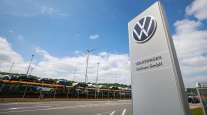Special to Transport Topics
Technology Provider Hopes to Strike Balance on Diesel Engine

[Stay on top of transportation news: Get TTNews in your inbox.]
Diesel engines have long dominated the heavy-duty truck market because of their performance characteristics, but they also generate a significant amount of greenhouse gas emissions. Alternative fuels, on the other hand, don’t always pack the same powerful punch as diesel-fueled engines or face other challenges and limitations. But ClearFlame Engine Technologies is working to develop a diesel engine that runs on cleaner fuel without compromising performance.
Co-founders BJ Johnson and Julie Blumreiter launched the Geneva, Ill.-based startup in 2016 and recently began working with engine manufacturer Cummins Inc. on a pilot project demonstrating the technology. In addition, the U.S. Department of Energy recently awarded ClearFlame a two-year, $1.1 million Small Business Innovation Research program grant to support continued research and development.
ClearFlame aims to maintain the traditional diesel engine design to ensure the practicality and convenience that diesel-burning engines offer while reducing emissions by burning cleaner fuels including ethanol, methanol or natural gas. The technology would still provide the high amounts of torque and transient response found in traditional diesel engines.

►Refrigerated carriers finding value with electric-powered reefer units
►Technology used to strengthen truck and trailer inspection procedures
►Technology provider hopes to strike balance on diesel engine
►Telematics strengthens communication between delivery driver and dispatch
►Baxter: Considerations for hydrogen-electric trucks
“Part of the value is it doesn’t look different and it is easy to adopt. Innovative technology doesn’t mean you have to give up what you know or understand,” Johnson said.
ClearFlame’s concept is relatively fuel agnostic, meaning the engine can run on nearly any low-carbon fuel. Ethanol is of particular interest due to its cost and availability. Although ethanol works well in spark-ignited engines for passenger or light-duty vehicles, it hasn’t found widespread success for heavy-duty trucking.
“Spark-ignited engines don’t have the torque characteristics you need to pull a large load … [and] alcohol fuels don’t want to auto ignite or burn on their own. In a diesel engine, you rely on that,” said Dr. Adam Dempsey, assistant professor of mechanical engineering at Marquette University. “One of [ClearFlame’s] big ideas is to use coatings that keep the heat in the engine and would allow the alcohol fuel to auto-ignite.”
Dempsey met the ClearFlame team when he worked at Caterpillar as a combustion research engineer on a team that sought emerging and future engine technologies.
Another goal is to ensure the technology is cost effective. The startup is trying to achieve at least parity with — if not a financial edge over — diesel engines.
Developers approach this from several fronts; first by eliminating the need for expensive aftertreatment systems, which aren’t necessary if vehicles run on cleaner-burning fuel. Instead, ClearFlame’s technology allows the use of a three-way catalyst system that reduces three emissions — nitrogen oxides, carbon monoxide and unburned hydrocarbons — much like a light-duty vehicle.

ClearFlame co-founders BJ Johnson and Julie Blumreiter. (ClearFlame)
“This has the potential to significantly decrease the cost of emission control,” said DOE’s Vehicle Technologies Office.
Three-way catalyst systems generally cannot achieve the proper air-to-fuel ratio, or stoichiometry, on diesel engines, but “ClearFlame has demonstrated that you can run this stoichiometric mixture if you use a fuel that doesn’t make soot. … That is another piece of their recipe,” Dempsey said.

Home | Video | Heroes' Photo Gallery
Saluting the men and women of the trucking industry who kept America's essential goods flowing during the coronavirus pandemic.
Heroes: Peter Lacoste | Susan Dawson | James Rogers | Reggie Barrows | Kevin Cooper | Cesar Quintana Moreno
Existing diesel engines that run on natural gas tend to bear more upfront costs than standard diesel engines. In addition, they consume fuel less efficiently, resulting in a loss of environmental benefits. The inferior fuel consumption means natural gas trucks usually need larger fuel tanks, which further hampers efficiency with added weight. ClearFlame’s model doesn’t suffer from those fuel efficiency losses, Johnson said.
Electric trucks, meanwhile, carry the extra weight of battery packs.
“We are absolutely a diesel engine in every sense except the fuel,” Johnson said. “And we’re a whole lot easier to implement at a production level at scale, and at a fueling infrastructure level” due to the country’s well-established liquid fueling infrastructure.
Commercialization Challenges
Like all emerging technologies, ClearFlame faces some hurdles. The biggest is getting the innovation in front of the right audiences and helping them to understand its potential, Johnson said.
Although North America does have robust liquid fuel infrastructure, pure ethanol or methanol distribution is not yet common.

Dempsey
“You can get E85, but the fuels they’re using today in the lab are not at the gas pump … It’s going to be some time before that happens. That’s a hurdle,” Dempsey said.
Another barrier is material compatibility. Fuels such as ethanol can create a gummy residue when burned and erode engine gaskets.
“Those issues will exist in heavy-duty engines, but I view them as very solvable engineering problems,” Dempsey said.
As a technology provider, ClearFlame aims to partner with OEMs for product manufacturing. In the meantime, the company hopes to collaborate with others to demonstrate the technology’s efficacy across numerous engine platforms. Results of the Cummins pilot are expected soon.

What are industry executives doing to help bring more women into the fold, not only as drivers, but in leadership roles? Host Michael Freeze talks with Ellen Voie of Women In Trucking and Debora Babin Katz of TrucBrush Corp. Hear a snippet, above, and get the full program by going to RoadSigns.TTNews.com.
DOE’s Vehicle Technologies Office notes that methanol and ethanol are leading candidates as future zero-carbon fuels because of their energy density, low-energy requirements during production and market familiarity, and “ClearFlame provides an opportunity to take advantage of those potential future resources.”
The startup still has months — or possibly years — before its product reaches commercialization. Yet, subject matter experts with knowledge of the technology said the blend of environmental, economic and operational benefits stands to get engine manufacturers’ attention and has huge potential to reach the market.
“It’s very difficult to see any other technology that is going to be a very streamlined replacement for the diesel engine, so their main idea of cleaning it up by using very clean burning fuels is something that I think should resonate with almost anybody in the heavy-duty industry. It’s very logical,” Dempsey said.
Want more news? Listen to today's daily briefing:
Subscribe: Apple Podcasts | Spotify | Amazon Alexa | Google Assistant | More




